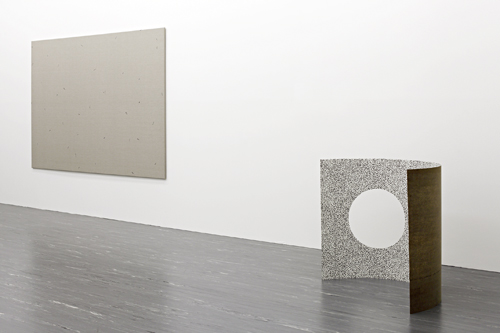Andy Boot
Patterns, relations and planes of reference
Patterns, relations and planes of reference

One could argue that the rejection of art historical imprimatur by artists coming of age in today’s market is rooted in the technological advancements that marked the end of the Cold War. Yet the impulse to maintain a relevant dialogue with historical precedents, as a vetting system, prevents the complete dissolution of narrative (contrary to Hans Belting and Arthur Danto). While the relational artists of the 1990s hedged their bets on the social cachet of the event without conceiving of the pervasiveness of social media today, young artists innately absorb the omnipresent network. In the best cases this results in uncomfortable relationships between subjects, objects and situations – and in not-so-good cases reifies the zeitgeist as an exercise of data flow.
Born in Sydney in 1987 and now living between Sydney and Vienna, Andy Boot produces work haphazardly entangled in the history of painting and modernist legacies yet conscious of the dwindling affect of material form and the shifting status of the work of art. His book Backgrounds, Surfaces and Landscapes, published in 2011, invokes traditional means for evaluating a picture but renders the terrain of engagement more fluid on its pages: finger-painted food-dye on sketching paper (Untitled, 2010); a lonely rubber fencepost (Untitled, 2010); a 3D molded, standardized dot-pattern digital print with a striking affinity to a pair of underpants (Untitled (Nefertiti), 2011). This mediatic playfulness extends to Boot’s paintings, most obviously the white canvas of placeholder (2012), that could be mistaken for a too neat Robert Ryman, but confers a more horrifying blankness: thinly traced diagonal lines indicating the image object’s empty frame in Adobe Creative Suite. This work was shown alongside eight others in the artist’s 21er Raum presentation at Vienna’s 21er Haus in 2012, collectively titled Überfläche – a play on the German word for ‘surface’.

The largest plane on view, in fact, was the original ash-grey streaked linoleum floor itself. Arranged over this ocean-like expanse (which recalled the soothing banality of the sea, as pictured in his earlier Untitled (Herringbone one – four), 2011), Boot’s post-Minimal paintings and sculpture seemed to float, gently appealing to the viewer through a subtle complex of relations. Untitled (bacterio) (2010) – a miniaturized portable theatrical backdrop with a pattern modified from a Memphis design – picked up the floor motif to perhaps literally roll away with it. Here it was rendered for the most part functionless, as a scrolling image with the further potential to ‘go viral’ in fungible digital space. A larger section of this same laminate was stood on edge in the corner opposite. Surface (two) (2010) drifted languidly into the background until closer inspection revealed a circular hole punched through its curved expanse.
The cloudy monochrome canvas cats (2012) harboured a handful of fuzzy, eponymously-shaped adhesives in its fast and loose brushwork. These were more cleverly camouflaged than the bumbling cat burglars, with permanent marker scrawled on their faces, were tacked to the draped black pigment of sharpies thumb (2010) – a painfully awkward reminder of the indelibility of mark-making. These two paintings referred back to the series of monochromes shown last year at Renwick Gallery in New York, each named for the coordinating shade of scratch-and-sniff decal applied to its acrylic-coated surface: berry, bubble gum, lemon, dry martini (all 2012). If cheerfully consonant from a visual standpoint, the series described a sort of product-based synesthesia: colour for the nose, and, after Artschwager, sculpture for the eye and painting for the touch.

Boot also makes works which seem coincidental, their category as objects precarious or accidental. His series of paintings, including e who remained was M (2012), comprises the traces left by shell pasta steeped in watercolour and casually cast onto unstretched canvas, linen or paper. But the poetics of pliant wet pasta are most clearly shown in his wall-based works Untitled (Black), Untitled (Navy Blue) and Untitled (Pink) (all 2012), which see loose folds of pigmented gymnastic ribbon suspended in baths of milky wax. For these, the surface captures a strand of material lengthier and more dynamic than itself: flexibility and locomotion fixed within the standardizing format of the canvas.
The ability of a network to bear out sundry relationships is key to the young artist’s heterogenous oeuvre, which consistently brings together mundane objects and materials in a manner which undermines familiar associations, using economical means to expand the frame of reference beyond the simple juxtaposition of high and low. For Boot, the narrative, like the network, already exists; it is the viewer’s relationship to it and the objects flowing in its stream which require reevaluation – a nudge, or two.
















